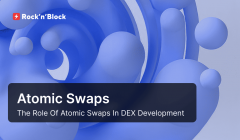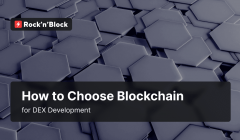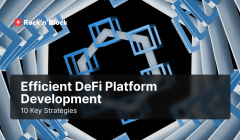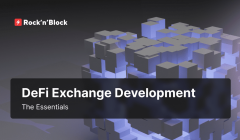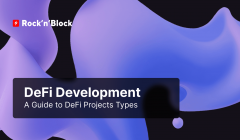How to Create a DEX: Key Steps and Considerations
03 May 2024In the dynamic landscape of decentralized finance, the creation of a decentralized exchange stands as a gateway to unlocking the vast potential and possibilities within this transformative ecosystem.
This article is here to help you develop your own DEX. Follow along as we explore the steps to unlock the true potential of DeFi! We'll provide you with key insights and steps to create a DEX that stands out in the competitive DeFi landscape.

Table of Contents:
-
The Rise of Decentralized Exchanges (DEX)
-
What to Keep in Mind When Creating Your DEX
-
How to Create Your Own DEX
-
Setting Up Development Environment
-
Smart Contracts and Blockchain Integration
-
User Interface Design
-
Security Considerations
-
Testing Your DEX
-
Mainnet Deployment and Launch
-
Summary of Key Takeaways
The Rise of Decentralized Exchanges (DEX)
Decentralized exchanges are a pivotal advancement in the evolving DeFi landscape. If you're looking to create a DEX and participate in the transformative journey of decentralized finance, it's crucial to understand its significance and advantages over Centralized Exchanges (CEX).
The Role of Decentralized Exchanges
DeFi exchange development plays a significant role in transforming the traditional financial landscape because it enables peer-to-peer transactions without intermediaries. With DEXs, you have full control over your assets, which promotes financial autonomy and inclusivity by eliminating central control. The decentralized nature of DEXs is in line with the core principles of DeFi, providing a transparent and trustless platform for seamless trading of various assets.
Advantages of DEX over CEX
When you create a DEX, one of the main benefits is improved security because DEXs reduce the risks associated with centralized control. Additionally, DEXs promote financial privacy, as users maintain ownership of their private keys and sensitive information.
Decentralized exchanges have the advantage of eliminating the risk of manipulation and failure due to the absence of a central authority. This provides users with a more reliable and resilient trading environment. Additionally, DEXs foster a global and inclusive financial ecosystem, allowing users worldwide to participate without geographical restrictions.
What to Keep in Mind When Creating Your DEX
Before embarking on the journey to create a DEX, thorough considerations are essential to lay a robust foundation for success. In this section, we will explore the crucial aspects that demand attention before initiating DEX development.
Market Research and Analysis
To create a DEX, first conduct thorough market research and analysis. It's essential to identify the target audience and understand their needs to tailor your DEX to meet specific requirements. By incorporating user-centric features, a DEX can gain a competitive edge and appeal to its intended audience. This step is crucial in creating a DEX that addresses the diverse needs and preferences of users.
Key points:
-
Understanding the demographics, preferences, and pain points of users can really help create a DEX that aligns with their expectations. By catering to specific user needs, a DEX becomes a valuable and desirable platform within the decentralized finance ecosystem.
-
To create a DEX that stands out, a comprehensive analysis of competitor DEX platforms is imperative. Studying the strengths and weaknesses of existing solutions provides valuable insights for differentiation. Identifying gaps in the market and potential areas for improvement allows for strategic positioning in the competitive landscape, ultimately contributing to the success of the DEX.
Are you curious about how to develop a platform like industry leaders? Check out our guides here!
Legal and Regulatory Considerations
Creating a DEX requires navigating the legal and regulatory landscape while adhering to established standards and guidelines. By understanding the legal considerations and regulatory requirements, you can ensure a compliant and trustworthy DEX that operates seamlessly within the DeFi ecosystem.
Key points:
-
Developing a DEX requires a profound understanding of the regulatory frameworks that govern decentralized finance. Each jurisdiction may have unique regulations that affect the creation and operation of a DEX. It's important to comply with these regulations to avoid legal issues and promote a sustainable DEX ecosystem.
-
Consulting legal experts is a first step to make during the pre-development phase to navigate the complex legal landscape. Legal professionals who specialize in blockchain and cryptocurrency can provide invaluable guidance on compliance requirements, helping to mitigate legal risks and ensuring that the DEX operates within the law regulations.
Tokenomics and Economic Model
Incorporating a native token in your DEX not only provides practical benefits such as reduced transaction fees and governance participation, but also adds a unique dimension to the platform that sets it apart in the decentralized exchange landscape. In the effort to create a DEX, careful attention to tokenomics and the economic model is critical. Tokenomics includes the utility and distribution of tokens and forms the basis of the DEX's economic structure. Establishing a sustainable economic model is crucial for the long-term viability and growth of the DEX.
Key points:
-
Before embarking on the development journey of your DEX, it is strategically imperative to consider its economic model. It involves examining revenue streams, resource allocation, and incentive structures meticulously. Crafting a well-thought-out economic model lays the groundwork for a financially sound and resilient platform. To achieve this, fundamental questions such as how the DEX will generate income, allocate funds for development and marketing, and incentivize liquidity providers must be addressed.
-
Creating a DEX involves defining the utility and distribution of tokens. The token's utility should align with the platform's functionalities to incentivize user engagement. Additionally, distribution strategies, such as rewarding liquidity providers, can contribute to a balanced and dynamic token ecosystem.
-
Creating a sustainable economic model is crucial for the longevity and success of the DEX development. Balancing token supply, incentives, and governance mechanisms contributes to a resilient economic framework. A financially sustainable DEX attracts and retains users, fostering a thriving ecosystem over time.
We're here to help you navigate your way through DEX development, so we've prepared a helpful article outlining the Top 10 Strategies for Seamless DEX Development!
Defining Technology Stack
To ensure optimal performance and smooth operation of your DEX, it's important to carefully evaluate the technology stack. Your choice of blockchain platform and smart contract standards will have a direct impact on the scalability, security, and interoperability of your DEX.
Key points:
-
Choosing the Right Blockchain Platform
Selecting the right blockchain for DEX development is a crucial decision. The platform you choose will determine factors such as transaction speed, cost, and ecosystem support. Selecting the right blockchain platform for DEX development is a critical decision that will have a significant impact on the entire project.
Each blockchain platform has its own unique characteristics, consensus mechanisms, and smart contract capabilities. It is important to note that the choice of blockchain directly impacts the stack on which smart contracts will be written, ultimately shaping the development process. For example, Solidity is used by Ethereum and EVM-compatible networks, Rust is leveraged by platforms like Solana and Near, and Haskell is utilized by Cardano. These different technology stacks not only impact the development landscape but also affect developer skill sets and associated costs.
This makes the selection of the blockchain platform and corresponding technology stack a crucial consideration in both the strategic and financial aspects of development.
-
Frontend Technologies
In DEX development, the frontend technology stack is crucial for ensuring a seamless and user-friendly experience. The frontend acts as the user interface, serving as the gateway for users to interact with the decentralized exchange. Selecting the appropriate frontend technologies requires considering factors such as responsiveness, intuitiveness, and scalability. React and Vue.js are often used to create dynamic and responsive user interfaces, while Bootstrap and Tailwind CSS help achieve a polished and visually appealing design.
It is important to ensure that the frontend technology stack aligns with the overall architecture and performance requirements of the DEX. A carefully chosen frontend technology stack is crucial for providing an enjoyable user experience, enabling seamless navigation, and guaranteeing the success of your DEX in the highly competitive decentralized finance arena.
Consider partnering with a DEX development company. These companies have in-depth knowledge of various blockchain platforms and technology stacks and offer tailored solutions to guide you through the development process. Collaborating with companies like Rock’n’Block will provide you with access to skilled developers who are proficient in the chosen stack. This can help reduce the learning curve and potential pitfalls associated with unfamiliar technologies. Working with DEX development specialists can accelerate the development timeline and provide valuable insights, ensuring that your decentralized exchange is built on a solid foundation. Partnering with a Decentralized Exchange Development Company may help you overcome technical challenges and ensure the success of your DEX project.
Choosing a DEX Development Partner
Embarking on the journey to create a DEX requires careful consideration when selecting a DEX development partner. In this section, we will explore the key steps for choosing a reliable partner.
Researching DEX Development Companies
Thorough research on DEX development companies is essential to ensure expertise, reliability, and a shared vision.
Key points:
-
Evaluating Past Projects
When you're searching for a DEX development company, reviewing their past projects is a fundamental step. By assessing the quality, functionality, and success of their previous DEX projects, you can gain valuable insights into the company's capabilities. A track record of successful projects is a good sign that a development partner is proficient in effective and competitive DEX software development.
-
Checking Client Testimonials
Client testimonials are a great way to gain insight into the client experience with a development partner. By analyzing feedback from previous clients, you can evaluate the level of satisfaction, communication, and collaboration. Positive testimonials are indicative of a DEX development company's commitment to client success.
Collaborative Approach
A collaborative approach between you and your chosen DEX development partner is crucial for a smooth and successful development process.
Key points:
-
Ensuring Effective Communication
Effective communication is the cornerstone of a successful collaboration, especially when seeking a development partner to create a DEX. A DEX development partner should prioritize transparent and regular communication to keep you informed about project progress, challenges, and milestones. Clear communication channels foster trust and ensure that your vision for the DEX is accurately translated into the development process.
-
Establishing a Clear Development Timeline
To manage expectations and ensure timely delivery, a clear development timeline is essential. A reliable DEX development partner will work with you to establish a realistic and transparent development roadmap. This timeline should include key milestones, testing phases, and the final launch of the DEX.
Choosing a DEX development partner is a pivotal decision to create a DEX. It's important to conduct comprehensive research on DEX development companies, including evaluating past projects and client feedback, to lay the foundation for a successful partnership. A collaborative approach, characterized by effective communication and a clear development timeline, ensures that your vision for the DEX is not only comprehended but also transformed into a competitive and functional decentralized exchange within the dynamic DeFi landscape.
Moreover, a competent development partner has a deep understanding of the key DEX development features that are essential to creating a successful decentralized exchange.
How to Create Your Own DEX
Creating your own DEX involves several critical steps that contribute to the development of a robust and user-friendly decentralized exchange. In this section, we'll provide an overview of the basic steps to create your own DEX.
We have created an in-depth guide to DEX Development in 2024. Check it out now!
1️⃣ Setting Up Development Environment
To create a DEX, you first need to establish a conducive development environment. This involves configuring the necessary tools and frameworks for a seamless and efficient process. Commonly used tools include version control systems like Git for code management and collaboration. For developing, testing, and deploying smart contracts on Ethereum, popular frameworks such as Truffle and Hardhat provide a solid foundation for DEX development.
2️⃣ Smart Contracts and Blockchain Integration
The heart of any DEX lies in its smart contracts. This phase encompasses writing smart contracts and deploying them to the blockchain, laying the groundwork for the DEX's core functionality.
Writing Smart Contracts
The role of smart contracts in DEX development is essential. These self-executing contracts define the rules and operations within the exchange. Writing smart contracts involves using languages like Solidity to implement functionalities such as order matching, trade execution, and token transfers.
3️⃣ User Experience and User Interface Design
User Experience (UX) and User Interface (UI) design play a pivotal role in the DEX development process. To create a DEX that can be used by people of any skill and technical level, it is critical to design a simple and intuitive UX that improves accessibility and encourages user engagement within the DEX.
Creating a Simple UX/UI
In DEX development, it's important to create a simple UX/UI that allows users to easily navigate and engage with the platform, regardless of their level of familiarity with blockchain technology. A simple and intuitive UX/UI design improves user interactions and makes functionalities such as trading, asset management, and liquidity provision more accessible. Clear navigation, concise presentation of information, and a visually appealing layout contribute to a positive user experience. Simplicity in UX/UI design not only enhances ease of use but also promotes mass adoption of decentralized financial services, making the DEX more inclusive.
4️⃣ Security Considerations
As you embark on the journey to create a DEX, prioritizing security considerations is paramount. This part delves into the critical aspect of smart contract audits, emphasizing the need for a robust security practices to safeguard your DEX and its users.
Smart Contract Audits
Following Security Practices in Decentralized Exchange Software Development is vital. Smart contract audits play a pivotal role in fortifying the foundation of your DEX and mitigating potential vulnerabilities that could compromise the integrity of the platform.
Key points:
They are crucial to identify and fix vulnerabilities in the code before deployment. They are a proactive measure to ensure the reliability of the code that governs the core functionalities of your DEX. Thorough security audits help build user trust by demonstrating a commitment to security and reliability.
User Data Protection
When creating a DEX, it's important to prioritize the protection of user data and fortify against potential threats.
Key points:
-
Implementing Encryption for User Data
Protecting user data starts with implementing encryption protocols. Encrypting sensitive user information ensures that the data remains unreadable and secure even in the event of unauthorized access. Using industry-standard encryption algorithms provides an additional layer of defense against potential data breaches.
Measures Against Hacks and Exploits
In the rapidly changing decentralized exchange development landscape, it is crucial to protect your DEX from hacks and exploits. To create a DEX that is secure and stable, it is essential to implement robust measures to ensure the integrity of your platform and the protection of user assets.
Key points:
-
Continuous Monitoring and Threat Detection
Establishing continuous monitoring mechanisms enables real-time threat detection. Utilizing security tools and algorithms to monitor for unusual activities or anomalies in the network allows for swift responses to potential threats. Proactive threat detection is a cornerstone in mitigating the impact of hacks.
-
Regular Security Audits and Penetration Testing
Conducting regular security audits and penetration testing is a way to identify and address potential vulnerabilities. Engaging third-party security experts to assess the DEX's infrastructure and codebase helps uncover potential weak points and ensures that security measures remain robust against emerging threats.
5️⃣ DEX Quality assurance (QA)
As you progress in the journey to create a DEX, thorough testing is a pivotal phase to ensure the functionality, security, and reliability of your decentralized exchange. This section explores the significance of testing, with a focus on testnet deployment and simulation.
Testnet Deployment and Simulation
Testnet deployment enables DEX developers to evaluate the performance of the DEX in a controlled environment that replicates mainnet conditions. This is important to identify and fix any bugs, glitches, or vulnerabilities before the DEX is exposed to real user transactions.
Simulating Real-World Scenarios
To comprehensively test your DEX, it's important to simulate real-world scenarios. By creating scenarios that mirror actual user interactions, market conditions, and trading activity, developers can observe how the DEX performs under various conditions. This includes order matching, trade execution, and the overall responsiveness of the platform.
Ensuring Security and Performance
Beyond functionality, testing on a testnet provides an opportunity to evaluate the security and performance aspects of your DEX, and it is a crucial step in creating a DEX. It helps identify and address security vulnerabilities in a simulated environment, which reduces the risks associated with potential attacks or exploits. Performance testing ensures that the DEX can handle varying loads and maintain optimal speed and responsiveness.
Stress Testing
Security stress testing involves intentionally putting the DEX through a variety of attacks and exploits to assess its resilience. By identifying vulnerabilities and weak points, DEX developers can implement additional security measures, which will strengthen the DEX's defenses against potential threats.
Performance Load Testing
Performance load testing evaluates how well the DEX performs under different levels of user activity. By simulating high transaction volumes and user loads, developers can ensure that the DEX remains responsive and efficient even during peak usage periods. Optimizing performance contributes to a positive user experience.
Leveraging specialized tools
Leveraging specialized tools for smart contract auditing enhances the effectiveness of the audit process. Tools such as MythX and Slither are commonly employed to analyze smart contract code, identify potential vulnerabilities, and ensure adherence to best practices. Integrating these tools into the audit workflow adds an additional layer of assurance.
6️⃣ Mainnet Deployment and Launch
The last step in creating a DEX is the mainnet deployment and launch phase. This represents the transition from development to the live environment. It requires meticulous preparation for a seamless entry into the DeFi landscape.
Final Security Checks
Before mainnet deployment, conducting final security checks is imperative. A thorough review of implemented security measures ensures a secure DEX that inspires user trust.
Gradual Rollout and Monitoring
Choosing a gradual rollout allows you to closely observe actual performance in live scenarios, ensuring a controlled introduction and prompt issue resolution.
Ongoing Improvements
Post-launch, staying agile and implementing improvements based on user feedback and market conditions contribute to long-term success in the dynamic DeFi landscape.
Summary of Key Takeaways
In summary, creating a DEX is a multifaceted journey that demands a comprehensive understanding of DeFi, technical proficiency, strategic considerations, and a commitment to security and user experience.
Creating a DEX can be exciting and rewarding, but the complex nature of decentralized finance and blockchain technology often requires expertise. Consider hiring a DEX development company, which may bring knowledge, experience, and a collaborative approach to ensure that your DEX aligns with your vision and meets high standards of functionality, security, and user experience.
In the competitive DeFi landscape, it's important to have a reliable and standout DEX platform. A trusted development partner can be the key to achieving this. By partnering with experts in the field, you can navigate the complexities of DEX development and pave the way for success in the decentralized future of finance.
We ❤️ Development
Follow us on social media to receive the hottest blockchain development updates
Twitter ⚡️Telegram⚡️LinkedIn⚡️Facebook
